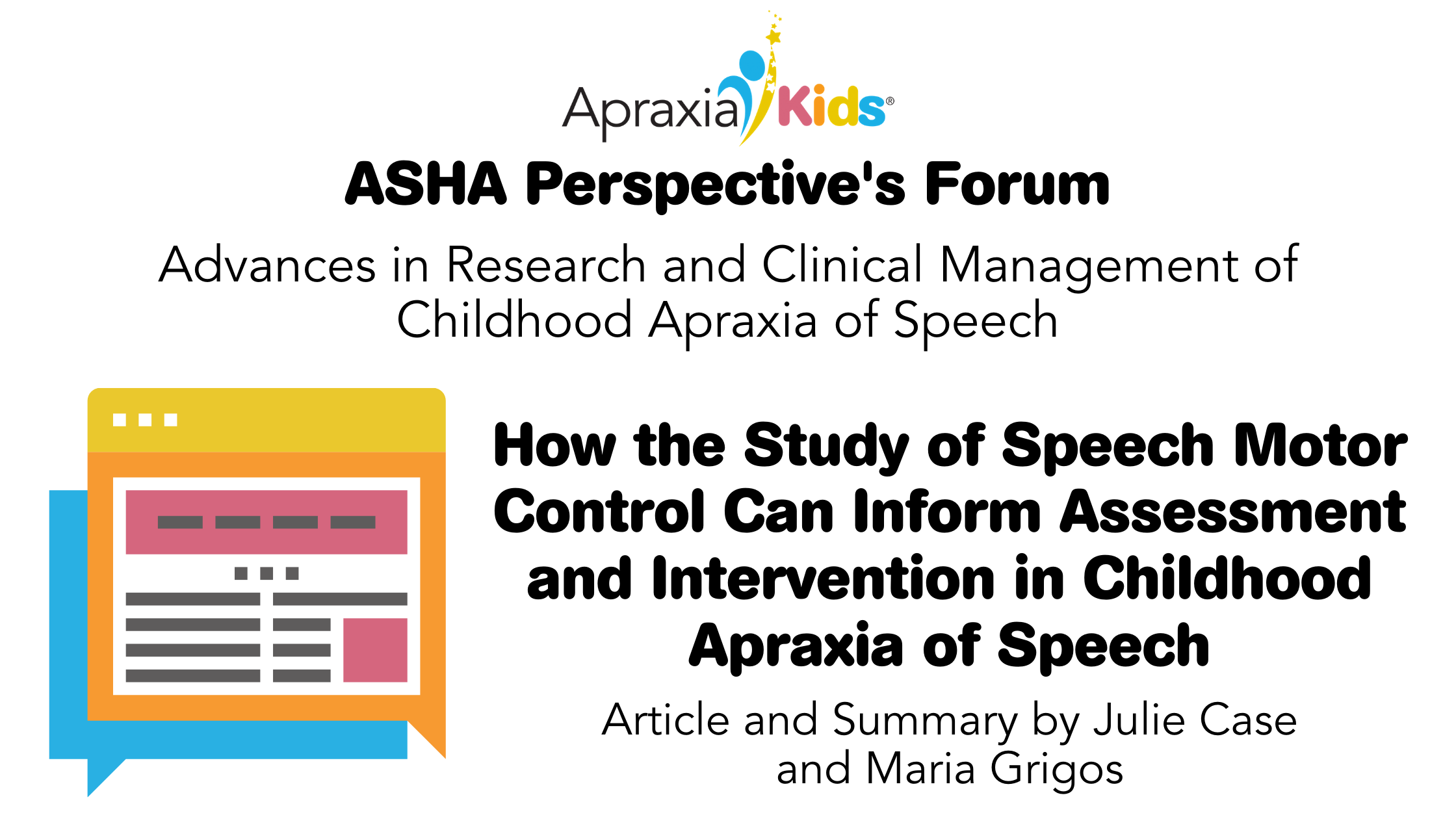
27 Aug How the Study of Speech Motor Control Can Inform Assessment and Intervention in CAS
Julie Case & Maria Grigos
This paper reviews the speech motor control research in CAS and discusses how these works have offered key information about the underlying motor deficits (Grigos, et al., 2015; Terband et al., 2019), the influence of structured practice on speech performance (Case & Grigos, 2016; Grigos & Case, 2018) and the role of task complexity (Case, 2019; Case & Grigos, 2016; Grigos & Case, 2018). For instance, studies of speech motor control have demonstrated that children with CAS display more variable articulator movement (Case & Grigos, in press; Grigos et al., 2015; Moss & Grigos, 2012; Nijland et al., 2002; Terband et al., 2019) and longer movement duration (Case & Grigos, 2016; Grigos et al., 2015) even within perceptually accurate speech as compared to typically developing peers and children with other speech sound disorders. The effect of the task demands on speech motor control is also discussed, as this body of research has found that in children with and without speech impairment, the variability of articulator movement and duration can differ according to the type of consonant-vowel combinations (Case & Grigos, 2016, in press; Grigos & Case, 2018), number of syllables in a word (Grigos et al., 2015), phonological complexity (Sasisekaran et al., 2010; Walsh et al., 2006), and utterance length (Maner et al., 2000; Sadagopan & Smith, 2008). The challenge we are now faced with as researchers and clinicians is bridging this body of literature to clinical practice.
Throughout this paper, the authors address this need through highlighting how we can use this research evidence to inform the clinical management of CAS. It is discussed how assessment must aim to more directly tax speech motor skills to obtain a thorough illustration of speech production deficits. Challenges related to intervention are also considered, as the treatment of CAS must not only improve production accuracy, but also facilitate more efficient motor planning and programming. Finally, the significance of motor-based intervention that applies motor learning principles and introduces variability across motor, phonetic, and prosodic contexts is emphasized as means of achieving this goal. Despite these gains, continued research is needed to better understand changes in speech motor control with intervention.
ASHA Sig 2 Perspectives Forum June, 2020
https://doi.org/10.1044/2020_PERSP-19-00114
Julie Case & Maria Grigos
This paper reviews the speech motor control research in CAS and discusses how these works have offered key information about the underlying motor deficits (Grigos, et al., 2015; Terband et al., 2019), the influence of structured practice on speech performance (Case & Grigos, 2016; Grigos & Case, 2018) and the role of task complexity (Case, 2019; Case & Grigos, 2016; Grigos & Case, 2018). For instance, studies of speech motor control have demonstrated that children with CAS display more variable articulator movement (Case & Grigos, in press; Grigos et al., 2015; Moss & Grigos, 2012; Nijland et al., 2002; Terband et al., 2019) and longer movement duration (Case & Grigos, 2016; Grigos et al., 2015) even within perceptually accurate speech as compared to typically developing peers and children with other speech sound disorders. The effect of the task demands on speech motor control is also discussed, as this body of research has found that in children with and without speech impairment, the variability of articulator movement and duration can differ according to the type of consonant-vowel combinations (Case & Grigos, 2016, in press; Grigos & Case, 2018), number of syllables in a word (Grigos et al., 2015), phonological complexity (Sasisekaran et al., 2010; Walsh et al., 2006), and utterance length (Maner et al., 2000; Sadagopan & Smith, 2008). The challenge we are now faced with as researchers and clinicians is bridging this body of literature to clinical practice.
Throughout this paper, the authors address this need through highlighting how we can use this research evidence to inform the clinical management of CAS. It is discussed how assessment must aim to more directly tax speech motor skills to obtain a thorough illustration of speech production deficits. Challenges related to intervention are also considered, as the treatment of CAS must not only improve production accuracy, but also facilitate more efficient motor planning and programming. Finally, the significance of motor-based intervention that applies motor learning principles and introduces variability across motor, phonetic, and prosodic contexts is emphasized as means of achieving this goal. Despite these gains, continued research is needed to better understand changes in speech motor control with intervention.
ASHA Sig 2 Perspectives Forum June, 2020
https://doi.org/10.1044/2020_PERSP-19-00114
Credentials:
Hours of Operation:
Treatment locations:
Address:
,
Phone:
Email:
Overall Treatment Approach:
Percent of CAS cases:
Parent Involvement:
Community Involvement:
Professional consultation/collaboration:
Min Age Treated:
Max Age Treated:
Insurance Accepted:




